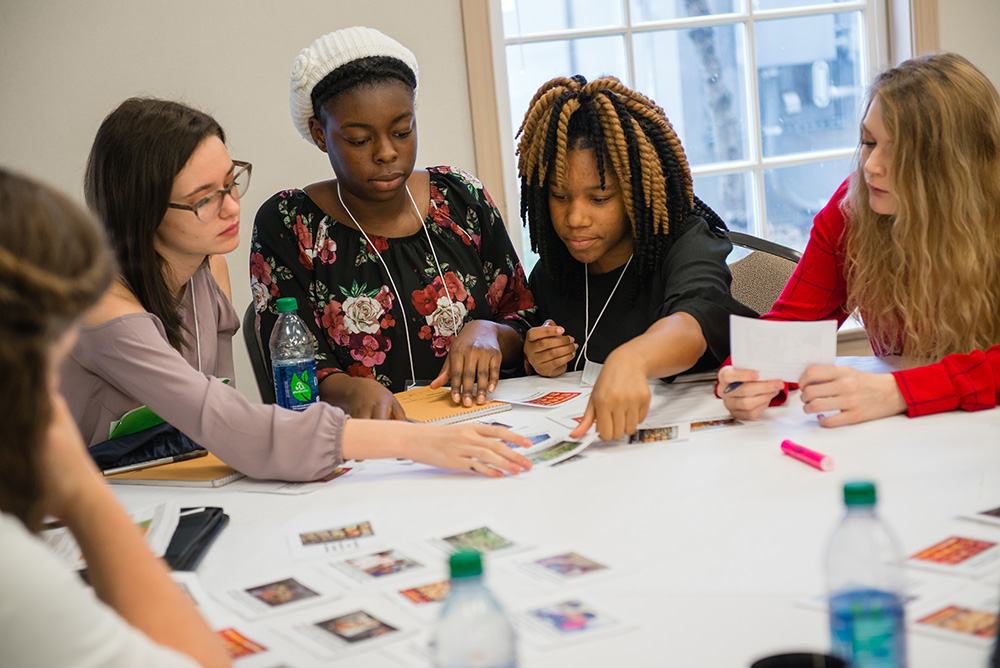2021 Pulse Check on Shared Stewardship for Thriving Together Across America
Overview
The Imperative of Shared Stewardship
Amidst compounding crises that threaten everyone’s health and well-being, America is seeing a groundswell of support to organize around a single unifying and measurable expectation: All people and places thriving together—no exceptions. This north-star expectation of thriving together cannot be realized with token gestures, technocratic approaches, or narrow programs. To get there, we must think and act very differently.
America is seeing a groundswell of support to organize around a single unifying and measurable expectation: All people and places thriving together—no exceptions.
A growing network of people and organizations see themselves—and one another—as stewards in a movement to thrive together, fostering systemic change with resourcefulness and agility, always seeking to craft a system that is built for well-being, equity, and racial justice. Stewardship is not a new idea, but it also is not yet widespread as a standard way of working together. It involves time-tested practices that have evolved over generations as people have endeavored to move beyond unjust or inhumane legacies and instead pass along a world that enables everyone to thrive.
A recent study about stewardship as a field of practice observed that, “the strength of our shared stewardship will likely determine whether we sink deeper into an adversity spiral, or whether we find pragmatic ways to create the vital conditions that all people need to participate, prosper, and reach their full potential.” With so much riding on shared stewardship, it becomes imperative to understand its current reach and dimensions.
Who are Stewards?
Everyone can be a steward. Stewards are people, organizations, and networks who take responsibility for working with each other to create conditions that everyone needs to thrive together, beginning with those who are struggling and suffering.
Throughout history, stewards have endeavored to extend what is healthy and humane, while working with equal vigor to resist and remove what is toxic and cruel.

Led by ReThink Health, the flagship initiative of the Rippel Foundation, in partnership with the RAND Corporation and funded by the Robert Wood Johnson Foundation and Rippel, the 2021 Pulse Check on Shared Stewardship for Thriving Together Across America is a large, methodologically rigorous effort to answer four questions:
- To what extent do changemakers across America endorse stewardship values?
- What are their priorities for investment and action?
- How fully are stewardship practices incorporated as organizational norms?
- What kind of obstacles and momentum builders shape the path forward?
The findings detailed below describe the current state of shared stewardship in the U.S. and shine a light on some of the values, priorities, and practices that could move us closer to a future in which all people and places can thrive together.
The results of the Pulse Check reveal that stewards across the nation are relatively well aligned around the ends they seek, albeit with some variation in their rationales. We found relatively small but revealing differences among respondents’ worldviews about why it is important to thrive together. Differences are larger when the subject turns to means, including significant divergence in opinions about priorities and practices. In other words, the survey finds strong agreement about what the destination is, less agreement about why it should be the destination, and still more differences about how best to get there.
The 2021 Pulse Check shares a message of hope: not only are you not alone but you are part of a growing movement.
The work of stewardship is frequently daunting. It can feel isolating, as if the problems you face are yours alone. Fortunately, the 2021 Pulse Check provides a message of hope for every steward. Not only are you not alone, but you are part of a growing movement that is becoming steadily more well defined and clear about its approach. And, in clarifying the extent to which certain values, priorities, and practices have taken hold across the country, the 2021 Pulse Check provides a timely and empirically sound resource to further establish shared stewardship as a nationwide norm.

Focus of the Pulse Check: Stewardship Values, Priorities, and Practices
This is the third Pulse Check survey that ReThink Health has conducted. Each survey in this series has taken the pulse of particular issues across America at one point in time. The first two focused explicitly on formal, multisector partnerships for health (also called coalitions, collaboratives, and alliances). The 2014 Pulse Check sought to describe characteristics of such partnerships, and the 2016 Pulse Check examined how those partnerships develop over time (see also this report in Health Affairs). The 2021 survey tracks the extent to which essential stewardship values, priorities, and practices have diffused across the country.
For the 2021 Pulse Check, we heard from over 300 leaders in organizations that are well positioned to act as stewards for thriving together in communities across the U.S. We sought to learn what they are doing (or not doing) to steward well-being in their communities, what worldviews guide their work, what factors contribute to (and impede) their momentum, and the extent to which they feel aligned with others.
Stewardship Values, Priorities, and Practices
Stewardship values, priorities, and practices can be embraced by individuals, organizations, and networks across all sectors and across many scales—neighborhoods, cities, counties, states, and nationally.
Stewardship Values
- Understanding that all people deserve equal opportunities to live their best possible lives, something that is not yet a reality in America
- Seeing opportunities for positive change even in times of crisis, rather than reverting to habits that are rooted in (and reinforce) the status quo
- Orienting toward system change as a central goal in all efforts
- Regarding authentic collaboration as the central vehicle for enacting system change
- Investing resources among those who have the most to gain
- Prioritizing creative uses of existing resources instead of seeing the acquisition of new resources as a precondition for progress
Stewardship Priorities
Vital conditions are properties of places and institutions that we all need if we are going to reach our full potential (e.g. food, humane housing, meaningful work and wealth, a sense of belonging). When vital conditions are absent or impaired, people tend to struggle and suffer, driving demand for urgent services. Urgent services are essential—things like acute care for illness or injury, addiction treatment, homeless services, or crime response—but they are temporary fixes that don’t directly produce thriving lives. There is no way to “urgent service” our way to thriving.
Stewards in every community strive to make decisions about their priorities and investments in a way that “adds up” meaningfully across organizations to alleviate adversity and unlock everyone’s full potential to thrive. They prioritize vital conditions while balancing investments in critical urgent services (see Figure 1). In addition, they understand the special role played by Belonging and Civic Muscle across the entire range of investment priorities: it is both a vital condition itself and a pragmatic capacity that drives equitable progress in every other area.
Figure 1: Well-being portfolio
Stewardship Practices
- Working with members of your community as full partners
- Assessing and planning for well-being throughout the community, not just for the people directly served by an organization
- Embedding strategies to increase equity, diversity, and inclusion within organizations and communities
- Setting priorities based on both a short-and long-term view (e.g., beyond 10 years)
- Crafting solutions that advance multiple goals at once, also known as multisolving
- Embracing new ideas and experimenting with new approaches
- Investing resources to expand well-being in the community
- Sharing in-kind resources (e.g., staff, space, knowledge) with other organizations
- Supporting policies to expand community well-being
- Strengthening collaboration across organizations to promote community well-being (e.g., hosting meetings, crafting agendas, facilitating dialogue, sharing information)
- Managing programs or resources with other organizations to support community well-being
- Finding ways to share and integrate data
- Monitoring and evaluating collaborative efforts to expand community well-being, equity, and racial justice
Methods and Limitations
Methods
See Appendix 2 for a detailed description of the 2021 Pulse Check procedures.
Whereas prior Pulse Checks surveyed only one type of organization (i.e., a formal multisector partnership), the 2021 Pulse Check has a much wider array of contributors. Insights from ReThink Health’s Ventures project affirmed that while formal partnerships play important roles in communities, other types of organizations also drive change even if they do not work through a formal partnership. The 2021 Pulse Check therefore looks across a wider spectrum of entities that play a role in fostering equitable, thriving communities. It includes contributors from eight types of organizations (see Figure 2):
- Governmental public health departments (city or county)
- Hospitals
- Business associations (for example, local chambers of commerce)
- Community non-profits, including multisector partnerships and organizations focused on food, housing, the environment, and faith and social justice.
The questions in the 2021 Pulse Check survey (see Appendix 1 for the survey instrument) are grounded in observations from ReThink Health’s fieldwork with hundreds of individuals and organizations, as well as findings about transformational norms and practices from a growing body of literature across a range of interdisciplinary fields. Some of those fields include democratic governance of common resources, collaborative governance, large-scale community organizing, complex adaptive systems, othering and belonging, learning organizations, network science, and health system dynamics, among others (Ostrom, 2009; Emerson and Nabatchi, 2015; Ganz, 2010; Eoyang, 2001; Snowden and Rancati, 2020; powell, 2012; Senge et al., 1994; Centola, 2018; Varda, 2018; Sterman, 2006).

We designed and pre-tested the Pulse Check questions using focus groups with representatives from each of the eight organization types, including in-depth interviews for cognitive testing. In addition, our methodology produced a nationally representative sample that can be replicated in future surveys.
We followed these steps to build the sample:
- Identified Places: We identified the approximately 6,500 incorporated places and Census Designated Places in the United States that have a population greater than 10,000 and less than 500,000. From that set, we randomly selected a sample of 1,200 places. To properly represent larger cities (those with populations greater than 500,000), we randomly selected local neighborhoods, 44 in total.
- Identified Organizations: For each location in the sample we randomly assigned an organization type and then selected the largest organization of that type in that location.
- Identified an Informed Respondent: The director of the organization (or another informed organization leader) was invited to participate in the survey.
Our primary aim was to obtain a sample that was sufficiently large and balanced across sub-groups to support internally valid observations about the state of shared stewardship in the country. Because the Pulse Check surveys do not track changes over time, this report does not compare findings to prior Pulse Checks.
The task of fielding the Pulse Check was complicated by the COVID-19 pandemic, which exerted a disproportionate impact on different sub-groups. Notably, the response rate for people working in hospitals and public health departments was one-third that of people associated with business associations and community non-profits. To compensate, we increased the number of invitations sent to hospitals and public health departments and were able to achieve sufficient representation across each intended sub-group. The overall response rate of 9.7% was low in absolute terms but yielded a satisfactorily robust and balanced sample.

Study Limitations
Stewardship is grounded in the idea of co-creating equitable, thriving communities with a diverse ecosystem of constituents. This includes ordinary people in every walk of life, along with organizations in every sector or industry. The 2021 Pulse Check examines the diffusion of stewardship values, priorities, and practices—many of which are oriented towards centering unheard or underheard voices and building shared power—from the perspective of organizational leaders. We included community-based organizations that tend to work closely with community residents but did not survey unaffiliated residents themselves. The findings therefore reflect perceptions from organizational leaders, not members of the general public they work to support.
It is possible that respondents differed from non-respondents in notable ways. Because the invitation to contribute was explicitly framed around community well-being, it may have been more attractive to people who hold that as a primary concern and see it as a focus of their work.
In a small number of questions, we found very high rates of agreement (over 90%). Such strong agreement can indicate true alignment but may also reflect the impact of social desirability bias—i.e., respondents providing what they perceive to be the desired answer.
Relatedly, it is important to recognize that what people report does not always align with what they do. Aspirations about what one would like to be true—for instance, always collaborating with partners on an equal footing—may lead one to report a practice that is not fully borne out in daily behavior. Put another way: the 2021 Pulse Check tells us what people say they do—it does not tell us what they actually do. That is in the nature of any survey, but it is useful in revealing the current state of prevailing perceptions.
Figure 2: What organization types contributed to the 2021 Pulse Check? (n=348)
Contributors
We heard from 348 contributors across eight organization types, selected from a nationally representative sample of places across the country.
Respondents’ organizations primarily focus on the county level (34%), multi-county level (25%), or city level (14%). Organizational leaders report that their efforts reach racial and ethnic minorities (64%), low-income populations (63%), families (63%), children (61%), and the elderly (56%).
Respondents skewed female (58%), White (87%), and leaned Democrat (45%, compared with 8% Republican and 36% who preferred not to say). Two exceptions, however, are respondents from business associations and hospitals, who are more likely to be male (59% and 58%, respectively) and to lean Republican (22% and 13%, respectively). This is generally consistent with the population of people who hold senior positions in these organizations across the country.
Throughout the report, we often group the eight organizations into four clusters:
- Governmental public health departments (city or county)
- Hospitals
- Business associations (for example, local chambers of commerce)
- Community non-profits, including multisector partnerships and organizations focused on food, housing, the environment, and faith and social justice.
We grouped themes from contributors in this way because there were often strong similarities or differences in responses, both within and across these clusters. Additionally, the clusters reflect major sectors that play unique and significant roles in supporting equitable, thriving people and places in the U.S.


